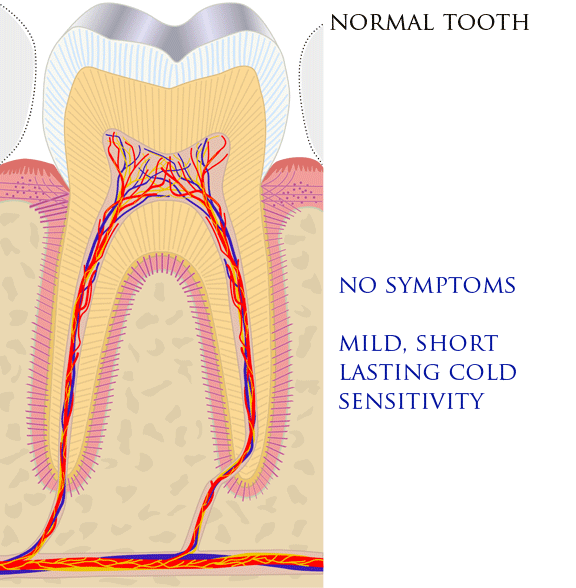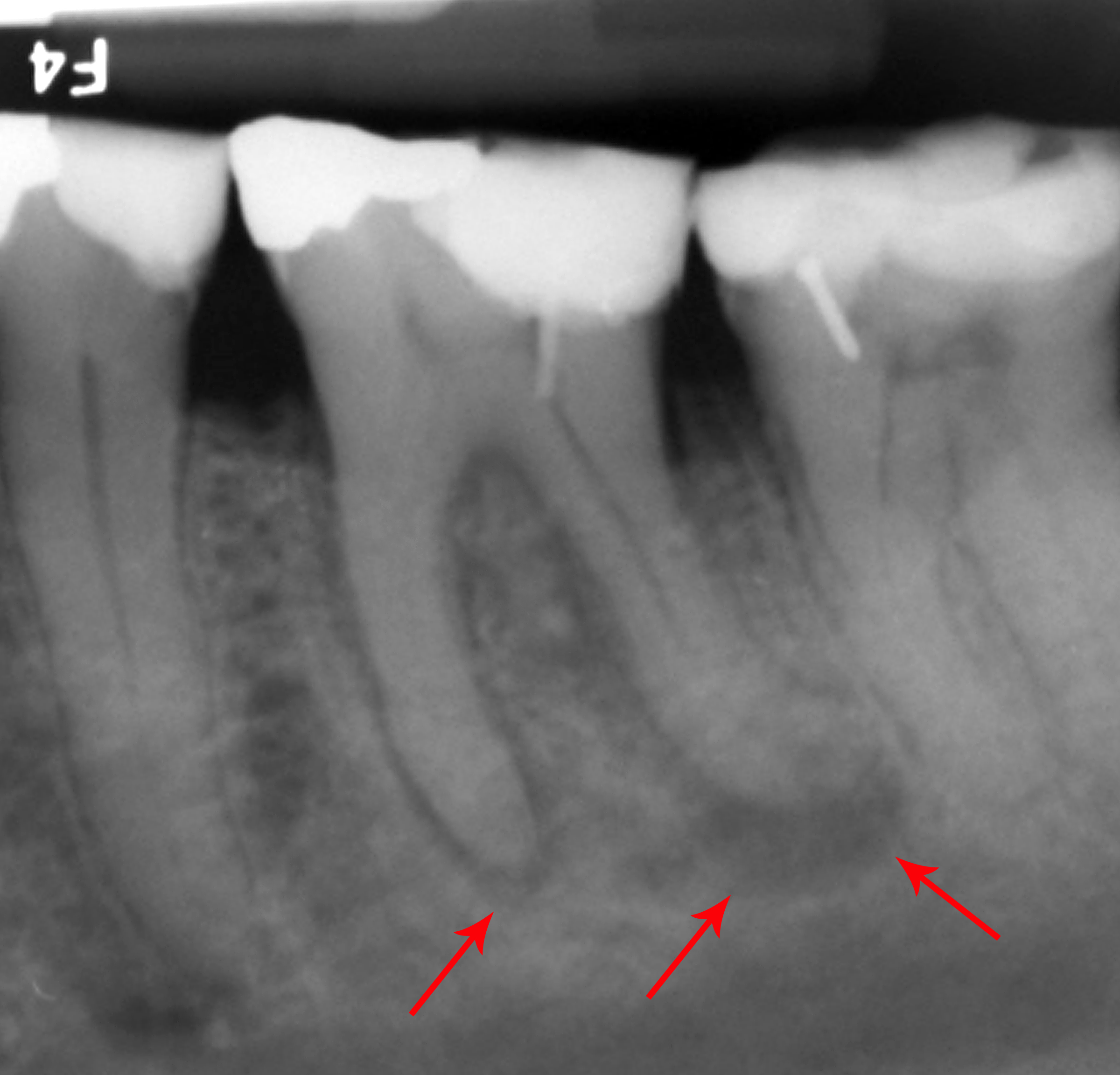|
Toothache
Toothache, also known as dental pain,Segen JC. (2002). ''McGraw-Hill Concise Dictionary of Modern Medicine''. The McGraw-Hill Companies. is pain in the teeth or their supporting structures, caused by dental diseases or pain referred to the teeth by non-dental diseases. When severe it may impact sleep, eating, and other daily activities. Common causes include inflammation of the pulp, (usually in response to tooth decay, dental trauma, or other factors), dentin hypersensitivity, apical periodontitis (inflammation of the periodontal ligament and alveolar bone around the root apex), dental abscesses (localized collections of pus), alveolar osteitis ("dry socket", a possible complication of tooth extraction), acute necrotizing ulcerative gingivitis (a gum infection), and temporomandibular disorder. Pulpitis is reversible when the pain is mild to moderate and lasts for a short time after a stimulus (for instance cold); or irreversible when the pain is severe, spontaneous ... [...More Info...] [...Related Items...] OR: [Wikipedia] [Google] [Baidu] |
Pericoronitis
Pericoronitis is inflammation of the soft tissues surrounding the crown of a partially erupted tooth, including the gingiva (gums) and the dental follicle. The soft tissue covering a partially erupted tooth is known as an ''operculum'', an area which can be difficult to access with normal oral hygiene methods. The hyponym ''operculitis'' technically refers to inflammation of the operculum alone. Pericoronitis is caused by an accumulation of bacteria and debris beneath the operculum, or by mechanical trauma (e.g. biting the operculum with the opposing tooth). Pericoronitis is often associated with partially erupted and impacted mandibular third molars (lower wisdom teeth), often occurring at the age of wisdom tooth eruption (15-26). Other common causes of similar pain from the third molar region are food impaction causing periodontal pain, pulpitis from dental caries (tooth decay), and acute myofascial pain in temporomandibular joint disorder. Pericoronitis is classifie ... [...More Info...] [...Related Items...] OR: [Wikipedia] [Google] [Baidu] |
Root Canal Treatment
Root canal treatment (also known as endodontic therapy, endodontic treatment, or root canal therapy) is a treatment sequence for the infected pulp of a tooth which is intended to result in the elimination of infection and the protection of the decontaminated tooth from future microbial invasion. Root canals, and their associated pulp chamber, are the physical hollows within a tooth that are naturally inhabited by nerve tissue, blood vessels and other cellular entities. Together, these items constitute the dental pulp. Endodontic therapy involves the ''removal'' of these structures, disinfection and the subsequent shaping, cleaning, and decontamination of the hollows with small files and irrigating solutions, and the ''obturation'' (filling) of the decontaminated canals. Filling of the cleaned and decontaminated canals is done with an inert filling such as gutta-percha and typically a zinc oxide eugenol-based cement. Epoxy resin is employed to bind gutta-percha in some ro ... [...More Info...] [...Related Items...] OR: [Wikipedia] [Google] [Baidu] |
William Hole (artist)
William Brassey Hole RSA (7 November 1846 – 22 October 1917) was a Scottish artist, illustrator, etcher, and engraver, known for his industrial, historical and biblical scenes. Life Early life and training Hole was born in Salisbury, Wiltshire, the son of a doctor, Richard Brassey Hole and his wife Ann Burn Hole (nee Fergusson); his father died in the cholera epidemic of 1849, when William was only 3 years of age, and the family relocated to Edinburgh, Scotland, shortly afterwards. He was educated at Edinburgh Academy, then served an apprenticeship as a civil engineer for 5 years, although he really wanted to be an artist.Meynell, 1887. In 1869, he sailed from Swansea to Genoa, and spent the next 6 months travelling and sketching around Italy. In Rome he made the acquaintance of Keeley Halswelle who gave him practical advice on art. It was Halswelle whose criticism encouraged Hole to endeavour to become a professional painter. On returning to Edinburgh, Hole entered ... [...More Info...] [...Related Items...] OR: [Wikipedia] [Google] [Baidu] |
Acute Necrotizing Ulcerative Gingivitis
Acute necrotizing ulcerative gingivitis (ANUG) is a common, non-contagious infection of the gums with sudden onset. The main features are painful, bleeding gums, and ulceration of inter-dental papillae (the sections of gum between adjacent teeth). This disease, along with necrotizing (ulcerative) periodontitis (NP or NUP) is classified as a necrotizing periodontal disease, one of the seven general types of gum disease caused by inflammation of the gums (periodontitis). The often severe gum pain that characterizes ANUG distinguishes it from the more common chronic periodontitis which is rarely painful. If ANUG is improperly treated or neglected, it may become chronic and/or recurrent. The causative organisms are mostly anaerobic bacteria, particularly Fusobacteriota and spirochete species. Predisposing factors include poor oral hygiene, smoking, poor nutrition, psychological stress, and a weakened immune system. When the attachments of the teeth to the bone are involved, the ... [...More Info...] [...Related Items...] OR: [Wikipedia] [Google] [Baidu] |
Dentistry
Dentistry, also known as dental medicine and oral medicine, is the branch of medicine focused on the teeth, gums, and mouth. It consists of the study, diagnosis, prevention, management, and treatment of diseases, disorders, and conditions of the mouth, most commonly focused on dentition (the development and arrangement of teeth) as well as the oral mucosa. Dentistry may also encompass other aspects of the craniofacial complex including the temporomandibular joint. The practitioner is called a dentist. The history of dentistry is almost as ancient as the history of humanity and civilization with the earliest evidence dating from 7000 BC to 5500 BC. Dentistry is thought to have been the first specialization in medicine which have gone on to develop its own accredited degree with its own specializations. Dentistry is often also understood to subsume the now largely defunct medical specialty of stomatology (the study of the mouth and its disorders and diseases) for which reas ... [...More Info...] [...Related Items...] OR: [Wikipedia] [Google] [Baidu] |
Orofacial Pain
Orofacial pain is a general term covering any pain which is felt in the mouth, jaws and the face. Orofacial pain is a common symptom, and there are many causes. Orofacial Pain (OFP) is the specialty of dentistry that encompasses the diagnosis, management and treatment of pain disorders of the jaw, mouth, face and associated regions. These disorders as they relate to orofacial pain include but are not limited to temporomandibular muscle and joint (TMJ) disorders, jaw movement disorders, neuropathic and neurovascular pain disorders, headache, and sleep disorders. Classification International Classification of Diseases (ICD-11) is a new classification coming into effect as of January 1, 2022. It includes chronic secondary headaches and orofacial pain. The classification has been established by a close cooperation between International Association for the Study of Pain (IASP), World Health Organization (WHO) and the International Headache Society (IHS). There are 4 main classifi ... [...More Info...] [...Related Items...] OR: [Wikipedia] [Google] [Baidu] |
Tooth Extraction
A dental extraction (also referred to as tooth extraction, exodontia, exodontics, or informally, tooth pulling) is the removal of teeth from the dental alveolus (socket) in the alveolar bone. Extractions are performed for a wide variety of reasons, but most commonly to remove teeth which have become unrestorable through tooth decay, periodontal disease, or dental trauma, especially when they are associated with toothache. Sometimes impacted wisdom teeth (wisdom teeth that are stuck and unable to grow normally into the mouth) cause recurrent infections of the gum (pericoronitis), and may be removed when other conservative treatments have failed (cleaning, antibiotics and operculectomy). In orthodontics, if the teeth are crowded, healthy teeth may be extracted (often bicuspids) to create space so the rest of the teeth can be straightened. Procedure Extractions could be categorized into non-surgical (simple) and surgical, depending on the type of tooth to be removed and other fac ... [...More Info...] [...Related Items...] OR: [Wikipedia] [Google] [Baidu] |
Dental Restoration
Dental restoration, dental fillings, or simply fillings are treatments used to restore the function, integrity, and morphology of missing tooth structure resulting from caries or external trauma as well as to the replacement of such structure supported by dental implants. They are of two broad types—''direct'' and ''indirect''—and are further classified by location and size. A root canal filling, for example, is a restorative technique used to fill the space where the dental pulp normally resides. Tooth preparation Restoring a tooth to good form and function requires two steps: # preparing the tooth for placement of restorative material or materials, and # placement of these materials. The process of preparation usually involves cutting the tooth with a rotary dental handpiece and dental burrs, a dental laser, or though air abrasion to make space for the planned restorative materials and to remove any dental decay or portions of the tooth that are structurally unso ... [...More Info...] [...Related Items...] OR: [Wikipedia] [Google] [Baidu] |
Oral Hygiene
Oral hygiene is the practice of keeping one's mouth clean and free of disease and other problems (e.g. bad breath) by regular brushing of the teeth (dental hygiene) and cleaning between the teeth. It is important that oral hygiene be carried out on a regular basis to enable prevention of dental disease and bad breath. The most common types of dental disease are tooth decay (''cavities'', ''dental caries'') and gum diseases, including gingivitis, and periodontitis. General guidelines for adults suggest brushing at least twice a day with a fluoridated toothpaste: brushing last thing at night and at least on one other occasion. Cleaning between the teeth is called interdental cleaning and is as important as tooth brushing. This is because a toothbrush cannot reach between the teeth and therefore only removes about 50% of plaque from the surface of the teeth. There are many tools to clean between the teeth, including floss, tape and interdental brushes; it is up to each individual ... [...More Info...] [...Related Items...] OR: [Wikipedia] [Google] [Baidu] |
Angina Pectoris
Angina, also known as angina pectoris, is chest pain or pressure, usually caused by insufficient blood flow to the heart muscle (myocardium). It is most commonly a symptom of coronary artery disease. Angina is typically the result of obstruction or spasm of the arteries that supply blood to the heart muscle. The main mechanism of coronary artery obstruction is atherosclerosis as part of coronary artery disease. Other causes of angina include abnormal heart rhythms, heart failure and, less commonly, anemia. The term derives from the Latin ''angere'' ("to strangle") and ''pectus'' ("chest"), and can therefore be translated as "a strangling feeling in the chest". There is a weak relationship between severity of angina and degree of oxygen deprivation in the heart muscle, however, the severity of angina does not always match the degree of oxygen deprivation to the heart or the risk of a myocardial infarction (heart attack). Some people may experience severe pain even though ... [...More Info...] [...Related Items...] OR: [Wikipedia] [Google] [Baidu] |
Sinusitis
Sinusitis, also known as rhinosinusitis, is inflammation of the mucous membranes that line the sinuses resulting in symptoms that may include thick nasal mucus, a plugged nose, and facial pain. Other signs and symptoms may include fever, headaches, a poor sense of smell, sore throat, a feeling that phlegm is oozing out from the back of the nose to the throat along with a necessity to clear the throat frequently and frequent attacks of cough. Generally sinusitis starts off as a common viral infection like common cold. This infection generally subsides within 5 to 7 days. During this time the nasal structures can swell and facilitate the stagnation of fluids in sinuses that leads to acute sinusitis which lasts from 6th day of the infection to 15th day. From the 15th day to 45th day of the infection comes the subacute stage followed by chronic stage. Whenever a chronic stage patient's immunity takes a hit the infection moves to "acute on sinusitis" stage and moves back to chro ... [...More Info...] [...Related Items...] OR: [Wikipedia] [Google] [Baidu] |
Chronic Periodontitis
Chronic periodontitis is one of the seven categories of periodontitis as defined by the American Academy of Periodontology 1999 classification system. Chronic periodontitis is a common disease of the oral cavity consisting of chronic inflammation of the periodontal tissues that is caused by the accumulation of profuse amounts of dental plaque. Periodontitis initially begins as gingivitis and can progress onto chronic and subsequent aggressive periodontitis according to the 1999 classification. Diagnosing chronic periodontitis is important in its early stages to prevent severe and irreversible damage to the protective and supportive structures of the tooth. However, due to chronic periodontitis being a painless progressing disease, few patients will seek dental care in the early stages. Mild to moderate chronic periodontitis can be managed by proper mechanical removal of the biofilm and calculus subgingivally. Full and effective oral hygiene and regular 3 monthly periodontal chec ... [...More Info...] [...Related Items...] OR: [Wikipedia] [Google] [Baidu] |







